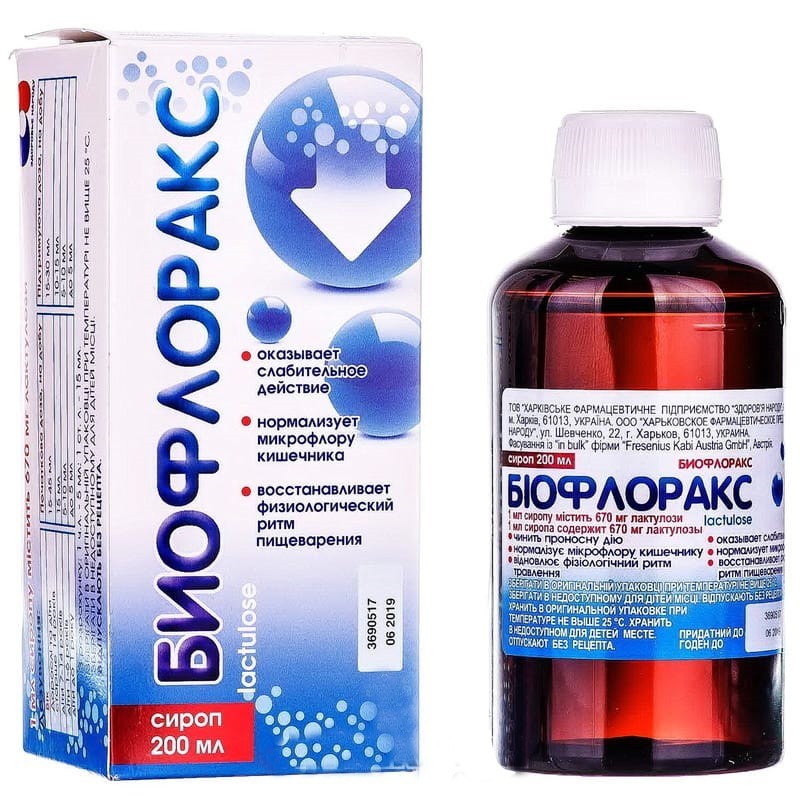



 Secure and encrypted payment processing
Secure and encrypted payment processing We ship to over 40 countries including the USA, UK, Europe, Australia and Japan
We ship to over 40 countries including the USA, UK, Europe, Australia and Japan Guaranteed refund or reship if you haven't received your order
Guaranteed refund or reship if you haven't received your orderLactulose has a laxative, hyperosmotic, hypoammoniaemic effect, stimulating intestinal motility, normalizes the intestinal microflora, improves the absorption of phosphates and calcium salts, promotes the excretion of protein breakdown products, is a breeding ground for lactic acid bacteria and promotes its development and reproduction. under its influence, the natural conversion of the drug in the large intestine to lactic, acetic, formic acid occurs completely, which contributes to an increase in acidity and osmotic pressure in the lumen of the large intestine, as well as an increase in intestinal motility (wave-like movements), an increase in the volume of feces, therefore, in the intestine binding of toxic decomposition products of protein compounds (ammonia). as a result, lactulose exhibits a mild laxative effect, without irritating the intestinal mucosa, and also reduces the content of toxic decomposition products of protein compounds in the blood, which are excreted from the body during the development of a laxative effect. also lactulose inhibits the growth of proteolytic microorganisms, including shigella, salmonella. the effect develops 24–48 hours after administration, its delay is due to the passage of the drug through the digestive tract. when ingested, lactulose is transformed in the intestine, decay products are excreted in the feces within 24–48 hours, no more than 3% of the drug is excreted unchanged in the urine.
Chronic and episodic (situational) constipation (including hemorrhoids, the need for surgical intervention on the large intestine and / or anus), postoperative atonic constipation, pain after removal of hemorrhoids, hepatic encephalopathy, liver failure, hepatic coma and precoma, chronic active hepatitis, hyperammonemia, intoxication of various etiologies, intestinal dysbiosis, putrefactive dyspepsia, salmonella carriage.
With constipation, pain after removal of hemorrhoids, putrefactive dyspepsia is prescribed according to the scheme:
| Age | In the first 3 days - the initial dose, ml | Over 3 days - maintenance dose, ml |
|---|---|---|
| Adults | 15–45 ml / day (1-3 tbsp. L.) | 15 ml / day (1 tbsp. L.) |
| Children aged 7-14 | 15 ml / day (1 tbsp. L.) | 10 ml / day (2 tsp) |
| Children aged 1 to 6 years | 5–10 ml / day (1–2 tsp) | 5–10 ml / day (1–2 tsp) |
| Newborns and children under the age of 1 year | 5 ml / day (1 tsp) | 5 ml / day (1 tsp) |
The course of treatment is from 1-4 weeks to 3-4 months.
When salmonella is prescribed in the first 10-12 days, 5 ml (1 teaspoon) 3 times a day, after a one-week break of 5 ml (1 teaspoon) 5 times a day for 10-12 days.
In case of liver failure, coma and precoma, encephalopathy, as well as chronic hepatitis, hyperammonemia, intoxications of various etiologies, dysbiosis, it is prescribed orally initially 30–60 ml (2–4 tablespoons) 3 times a day, then, as a rule, after 7– 14 days of administration, a maintenance dose of 10-25 ml (2-5 teaspoons) 2-3 times a day is prescribed. The course of treatment is up to 3 months.
300 ml of syrup per 700 ml of water or isotonic sodium chloride solution are administered rectally to patients in a hepatic coma or precomatous state, administered through a rectal balloon catheter and held for 30-60 minutes. If necessary, repeat every 4-6 hours.
When taken orally, the drug can be diluted with water or juice, with the exception of grapefruit.
The effect appears after 24–48 hours.
Galactosemia, intestinal obstruction, hypersensitivity to lactulose, rectal bleeding. it is not recommended to prescribe the drug for hepatic coma caused by hepatitis.
Bioflorax is usually well tolerated, but in the first days of use, flatulence and increased gas formation may appear, which disappear on their own 2-3 days after the start of treatment, in the treatment of hepatic encephalopathy - transient diarrhea, nausea, intestinal cramps are also possible. frequent use of the drug in high doses, especially in elderly patients, can cause diarrhea with a violation of the water-electrolyte balance.
At the beginning of treatment for liver failure, coma and precoma, encephalopathy, chronic active hepatitis, hyperammonemia, intoxications of various etiologies, when a laxative effect is achieved, a maintenance dose is prescribed so that it provides softened stools 2-3 times a day.
Elderly people and patients with mental disorders are recommended for prolonged treatment to control the electrolyte content in the blood.
With caution, the drug is prescribed for patients with diabetes due to the presence of sugar in the composition.
The drug can be used during pregnancy and lactation, as well as in newborns and young children.
When diarrhea occurs, the drug is stopped.
It is not recommended to use bioflorax simultaneously with neomycin and antacids to avoid a decrease in effect. it is not recommended to use the drug within 2 hours after taking other drugs.
Diarrhea is possible, followed by dehydration, hypokalemia and hyponatremia, which disappear when the drug is stopped or the dose is reduced. it is necessary to prescribe therapy to restore the water – electrolyte balance.
In a dry, dark place at a temperature of 15-25 ° C.